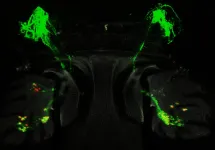INFORMATION:
Peer reviewed study / observational / people and cells END
UK variant spread rapidly in care homes in England
The UK variant of SARS-CoV-2 spread rapidly in care homes in England in November and December last year, broadly reflecting its spread in the general population, according to a study by UCL researchers
2021-03-16
(Press-News.org) The UK variant of SARS-CoV-2 spread rapidly in care homes in England in November and December last year, broadly reflecting its spread in the general population, according to a study by UCL researchers.
The study, published as a letter in the New England Journal of Medicine, looked at positive PCR tests of care home staff and residents between October and December. It found that, among the samples it had access to, the proportion of infections caused by the new variant rose from 12% in the week beginning 23 November to 60% of positive cases just two weeks later, in the week beginning 7 December.
In the south east of England, where the variant was most dominant, the proportion increased from 55% to 80% over the same period. In London, where the variant spread fastest, the proportion increased from 20% to 66%.
The researchers said the timing of infections suggested the new variant may have been passed from staff to residents, with positive cases among older people occurring later.
Senior author Dr Laura Shallcross (UCL Institute of Health Informatics) said: "Our findings suggest the UK variant spread just as quickly in care homes as it did in the general population. This shows the importance of public health measures to reduce transmission in the country as a whole."
Lead author Dr Maria Krutikov (UCL Institute of Health Informatics) said: "Our results are consistent with national trends, suggesting that the UK variant was present in care homes from early on, although our sample did not fully represent all care homes in England. As we carried out this work in December, we were able to inform public health decisions at the time.
"To see how viruses like Covid-19 are changing and to respond quickly and appropriately, it is really important we have an advanced surveillance system, with gene sequencing that can identify new variants as early as possible."
For the study, researchers analysed 4,442 positive PCR samples from care home staff and residents in England. These were all the positive tests of staff and residents processed from October to December at the Lighthouse laboratory in Milton Keynes, one of the UK's biggest coronavirus testing labs. Staff in care homes are tested every week, while residents are tested monthly.
PCR tests for SARS-CoV-2 are designed to detect three parts of the virus - the S gene, N gene, and ORF1ab. The UK variant, known as B.1.1.7., has changes in its S gene, or spike gene, which mean the tests do not detect this particular target.
This means researchers were able to identify the proportion of infections caused by the new variant by looking at the samples in which the other two targets, the N gene and ORF1b, were detected, but not the S gene.
They also compared Ct values, which show how much of the virus is present, to check the samples did not miss the S gene because they were "weaker" positive tests, with less viral material.
Their analysis showed that in late November, the proportion of infections associated with B.1.1.7 increased sharply in several regions of England. In London, this was from 20% (week beginning 23 November) to 66% (week beginning 7 December). In the east of England, it rose from 35% to 64% over the same period, while in the south east the increase was from 55% to 80%. The data was predominantly drawn from London, the south east and east of England and the Midlands, with fewer positive test samples from the north of England and the south west.
Most samples were from people aged under 65, as staff are tested much more frequently than residents. However, among samples from those aged over 65, the proportion of infections caused by the new variant rose from 14% in the week beginning 23 November to 76% in the week beginning 7 December. (The number of total positive samples was low - just 21 and 157 respectively.)
The research was conducted as part of the Vivaldi study looking at Covid-19 infections in care homes. It received support and funding from the Department of Health and Social Care.
ELSE PRESS RELEASES FROM THIS DATE:
Young adults in a 20-year-long study shed light on what matters for mental health of ethnic diverse youth
2021-03-16
Washington, DC, March 16, 2021 - A study in the Journal of the American Academy of Child and Adolescent Psychiatry (JAACAP), published by Elsevier, reports on the young adult assessment of the now 20-year longitudinal Boricua Youth Study (BYS), a large cohort that brings much needed insight about development and mental health of children from diverse ethnic background growing up in disadvantaged contexts.
The present article, with its companion report on prevalence of conditions and associated factors, provides an update on the study's fourth wave, which follows-up two probability-based population samples of children of Puerto Rican heritage. ...
FSU researchers discover how 'cryptic species' respond differently to coral bleaching
2021-03-16
Certain brightly colored coral species dotting the seafloor may appear indistinguishable to many divers and snorkelers, but Florida State University researchers have found that these genetically diverse marine invertebrates vary in their response to ocean warming, a finding that has implications for the long-term health of coral reefs.
The researchers used molecular genetics to differentiate among corals that look nearly identical and to understand which species best coped with thermal stress. Their research was published in the journal Ecology.
"Being able to recognize the differences among these coral species that cannot be identified in the field -- which are known as 'cryptic species' -- will help us understand new ways ...
Catching electrons in action in an antiferromagnetic nanowire
2021-03-16
The electron is one of the fundamental particles in nature we read about in school. Its behavior holds clues to new ways to store digital data.
In a study published in Nano Letters, physicists from Michigan Technological University explore alternative materials to improve capacity and shrink the size of digital data storage technologies. Ranjit Pati, professor of physics at Michigan Tech, led the study and explains the physics behind his team's new nanowire design.
"Thanks to a property called spin, electrons behave like tiny magnets," Pati said. "Similar to how a bar magnet's magnetization is dipolar, pointing from south to north, ...
The potential economic impact of volcano alerts
2021-03-16
The Volcano Alert Level (VAL) system, standardized by the United States Geological Survey (USGS) in 2006, is meant to save lives and keep citizens living in the shadow of an active volcano informed of their current level of risk.
A new study published in Risk Analysis suggests that, when an alert remains elevated at any level above "normal" due to a period of volcanic unrest, it can cause a decline in the region's housing prices and other economic indicators. Because of this, the authors argue that federal policymakers may need to account for the effects of prolonged volcanic unrest -- not just destructive eruptions -- in the provision of disaster relief funding.
A team of geoscientists and statistical experts examined the historical relationship ...
How to prevent short-circuiting in next-gen lithium batteries
2021-03-16
As researchers push the boundaries of battery design, seeking to pack ever greater amounts of power and energy into a given amount of space or weight, one of the more promising technologies being studied is lithium-ion batteries that use a solid electrolyte material between the two electrodes, rather than the typical liquid.
But such batteries have been plagued by a tendency for branch-like projections of metal called dendrites to form on one of the electrodes, eventually bridging the electrolyte and shorting out the battery cell. Now, researchers at MIT and elsewhere have found ...
USC Stem Cell scientists start a buzz around fruit flies in hearing research
2021-03-16
Even though a fruit fly doesn't have ears, it can hear with its antennae. In a END ...
Patient wait times reduced thanks to new study by Dartmouth engineers
2021-03-16
The first known study to explore optimal outpatient exam scheduling given the flexibility of inpatient exams has resulted in shorter wait times for magnetic resonance imaging (MRI) patients at END ...
In women, higher body fat may protect against heart disease death, study shows
2021-03-16
FINDINGS
A new UCLA study shows that while men and women who have high muscle mass are less likely to die from heart disease, it also appears that women who have higher levels of body fat -- regardless of their muscle mass -- have a greater degree of protection than women with less fat.
The researchers analyzed national health survey data collected over a 15-year period and found that heart disease-related death in women with high muscle mass and high body fat was 42% lower than in a comparison group of women with low muscle mass and low body fat. However, women who had high muscle mass and low ...
While drowning numbers soar, beach safety programs are largely unevaluated
2021-03-16
A global review of coastal drowning science has found there is only one study worldwide that has evaluated beach safety education programs in schools.
Researchers from UNSW's Beach Safety Research Group have conducted the first in-depth review specific to coastal drowning.
The study, published in PLOS ONE, reviewed 146 coastal drowning studies from around the world.
"We found that evaluation of coastal drowning prevention strategies is rare," said William Koon, the lead author of the study and a PhD candidate in the School of Biological, Earth ...
NYU Tandon professor wins NSF CAREER award for promising young researchers
2021-03-16
The National Science Foundation (NSF) selected an NYU Tandon School of Engineering professor who is developing new approaches to training deep learning (DL) artificial intelligence frameworks, to receive its most prestigious award for promising young academics.
Anna Choromanska, an assistant professor in the Department of Electrical and Computer Engineering (ECE), received a 2021 NSF Faculty Early Career Development Award, more widely known as a CAREER Award, which supports early-career faculty who have the potential to serve as academic role models in research and education.
A five-year, $532,892 grant will support a project that focuses on new, more efficient ways of training ...
LAST 30 PRESS RELEASES:
Heart-brain connection: international study reveals the role of the vagus nerve in keeping the heart young
Researchers identify Rb1 as a predictive biomarker for a new therapeutic strategy in some breast cancers
Survey reveals ethical gaps slowing AI adoption in pediatric surgery
Stimulant ADHD medications work differently than thought
AI overestimates how smart people are, according to HSE economists
HSE researchers create genome-wide map of quadruplexes
Scientists boost cell "powerhouses" to burn more calories
Automatic label checking: The missing step in making reliable medical AI
Low daily alcohol intake linked to 50% heightened mouth cancer risk in India
American Meteorological Society announces Rick Spinrad as 2026 President-Elect
Biomass-based carbon capture spotlighted in newly released global climate webinar recording
Illuminating invisible nano pollutants: advanced bioimaging tracks the full journey of emerging nanoscale contaminants in living systems
How does age affect recovery from spinal cord injury?
Novel AI tool offers prognosis for patients with head and neck cancer
Fathers’ microplastic exposure tied to their children’s metabolic problems
Research validates laboratory model for studying high-grade serous ovarian cancer
SIR 2026 delivers transformative breakthroughs in minimally invasive medicine to improve patient care
Stem Cell Reports most downloaded papers of 2025 highlight the breadth and impact of stem cell research
Oxford-led study estimates NHS spends around 3% of its primary and secondary care budget on the health impacts of heat and cold in England
A researcher’s long quest leads to a smart composite breakthrough
Urban wild bees act as “microbial sensors” of city health.
New study finds where you live affects recovery after a hip fracture
Forecasting the impact of fully automated vehicle adoption on US road traffic injuries
Alcohol-related hospitalizations from 2016 to 2022
Semaglutide and hospitalizations in patients with obesity and established cardiovascular disease
Researchers ‘listen in’ to embryo-mother interactions during implantation using a culture system replicating the womb lining
How changing your diet could help save the world
How to make AI truly scalable and reliable for real-time traffic assignment?
Beyond fragmented markets: A new framework for efficient and stable ride-pooling
Can shape priors make road perception more reliable for autonomous driving?
[Press-News.org] UK variant spread rapidly in care homes in EnglandThe UK variant of SARS-CoV-2 spread rapidly in care homes in England in November and December last year, broadly reflecting its spread in the general population, according to a study by UCL researchers


